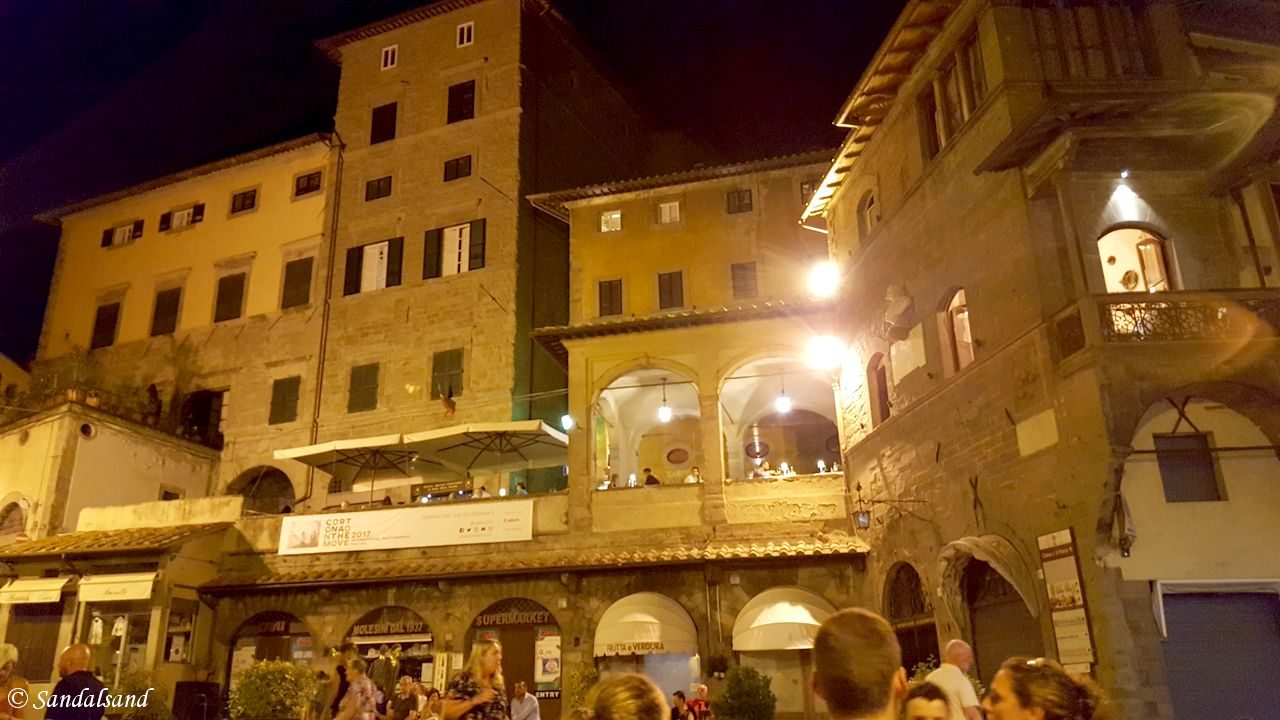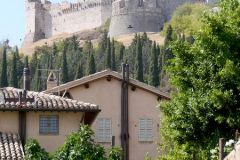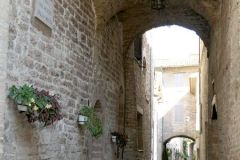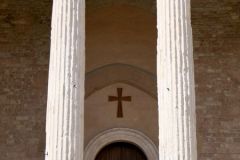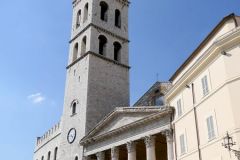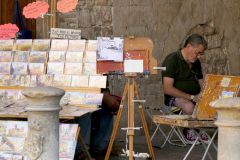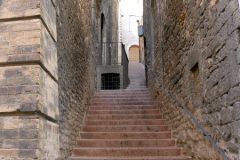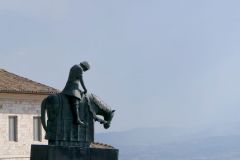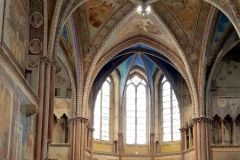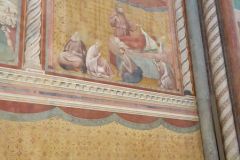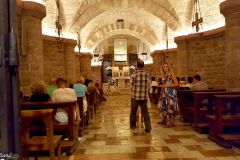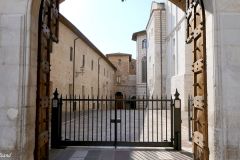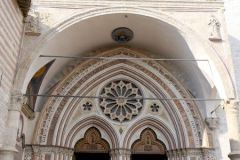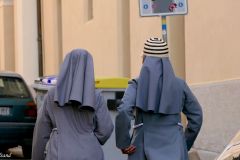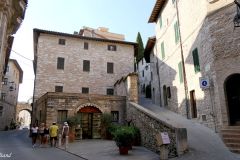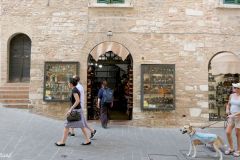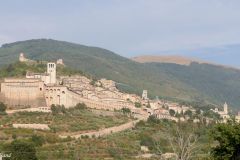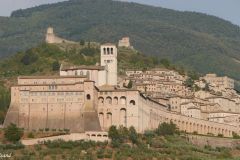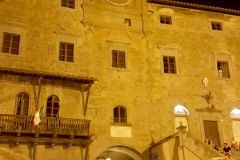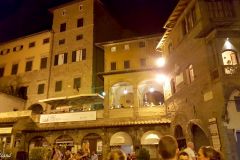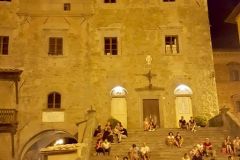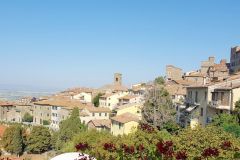We were on a road trip in central Italy. A string of very tempting cities were coming up in Umbria and Toscana (Tuscany) and we were eager to spend a couple of days on the road. It was now time for Spoleto, Assisi, Urbino and Cortona.
Day 2, Eremito – Spoleto – Assisi – Cortona
Previously on this road trip
We had spent the first night in remote monastery-like surroundings. We had finished a lovely breakfast and lunch and got in the car. Read the previous chapter about our stay at the Eremito. In normal circumstances it would have been possible to go through with today’s plan – visits to the World Heritage Sites in Spoleto and Assisi. Instead we prioritised lunch at the hotel. In addition we entered the E35 motorway in the wrong direction. The mistake proved an even greater one, because there were no exits for the next 20-30 km or so. Thirdly, I was beginning to feel uncomfortable, in short my belly was starting to nag me.
Missing Spoleto
We were hunting Spoleto, Assisi, Urbino and Cortona, but as it turned out we missed Spoleto. We should have gone south and then east to Spoleto. Instead we continued north and then east to Assisi, and dropped Spoleto altogether. Here is a collection of quotes describing what we missed.
The Basilica of San Salvatore in Spoleto is one of these seven monuments. A visit would have given us a look into yet another World Heritage Site. As it turned out, that will have to be on a later visit.
We continued on the E35 (A1) north to Bettolle and then turned east on good roads until we reached Assisi in less than 2 hours. Traffic was easy and the drive was uncomplicated.
A few quotes on Spoleto
Presided over by a formidable medieval fortress and backed by the broad-shouldered Apennines, their summits iced with snow in winter, Spoleto is visually stunning” (Lonely Planet)
Spoleto is among Umbria’s most charming large towns, divided into the medieval, hilltop Upper Town, home to the Duomo and most of the key museums and galleries, and the predominantly modern Lower Town, which nonetheless preserves a handful of Romanesque churches and Roman ruins. Known these days mainly for its big summer festival, it’s also remarkable for its thoroughgoing medievalism, an extremely scenic setting and several of Italy’s most ancient Romanesque churches.” (Rough Guides)
Spoleto is an important and popular historical town dating back to Roman times that is located in the southern part of the Umbria region of central Italy. The town contains numerous important monuments including a Roman theatre, an imposing fortress, a cathedral and several important churches.” (Italy this way)
The Longobards in Italy, Places of Power, 568 – 774 A.D.” comprises seven groups of monuments built by the Longobard / Lombard elite. They are considered a unique and exceptional testimony to the transition between antiquity and the European Middle Ages. (World Heritage Site)
About Assisi
Assisi, the birthplace of Saint Francis and his Franciscan Order, is no lesser sight than Spoleto. In historical terms, on the contrary. The setting is superb. It is situated almost at the foot of a mountain rising up from the flat plain. It is heavily fortified by a defensive wall like so many ancient Italian cities. In and around the town a cluster of buildings make up the UNESCO World Heritage Site of “The Basilica of San Francesco and Other Franciscan Sites“. The term “other” refers to four sites outside central Assisi: Le Carceri, San Damiano, Rivotorto and Santa Maria degli Angeli. They are all marked on the map below.
Read my special article about this heritage site.
A walk through Assisi
We were not particularly interested in the four additional structures and concentrated instead, on a hot summer’s day, on visiting the magnificent Basilica in addition to the town itself. A guidebook had advised us to look for Plaza Matteotti. It has an underground parking facility perfect to avoid the heat. In addition it has a perfectly location at the far end of the medieval city compared to the basilica at the other side. This gave us the opportunity to discover Assisi and go on a tiny pilgrimage to the Basilica. One should remember that the Basilica of San Francesco is Italy’s foremost pilgrimage site.
From here one just follows the signs, and of course, the tour groups. Assisi is a popular destination. However, it was surprisingly not packed with tourists, domestic or foreign, even on this Sunday in August. The first stop would be at the La Cattedrale di San Rufino and the fountain on the piazza in front of it, next would certainly be the Piazza del Comune Assisi. From here there are basically several streets to follow until the end – they all end at the Basilica some way or another. One should take it easy and enjoy the sights, churches, buildings, shops and whatever.
If you like, you might find interest in visiting the medieval fortress further up on the mountain-side.
Pictures from Assisi:
Cortona with a view
In the early evening we turned our car back west past Perugia and Lago Trasimeno and then turned north to another hillside town, Cortona. I first came here ten years ago and was completely enthralled by it then. I was not disappointed this time either. When Assisi had seemed surprisingly empty, Cortona was the opposite.
There are people everywhere, there are cars parked everywhere and the town is clearly a place where tourists gather – particularly during the evening. This is not a World Heritage Site like the ones we were looking for on this road trip in central Italy. On the other hand it is a pleasant Tuscan hillside town, full of charm and atmosphere – and it should not be missed.
In Cortona we had booked two nights at the Hotel San Luca. It has a tremendous location right on the edge of town overlooking the plain to the south and at the very entrance to the historic centre of town. Enjoy your breakfast on the terrace. There is no greater view in Italy.
Pictures from Cortona:
Day 3, Cortona – Urbino – Cortona
Urbino is a small hill town in the Marche region. It flourished in the 15th century and attracted artists and scholars from near and far. After a hundred years or so it slumbered into a sleep which it has never really woken up from. This means that the Renaissance appearance is remarkably present. UNESCO emphasises that Urbino represents a “pinnacle of Renaissance art and architecture, harmoniously adapted to its physical site and to its medieval precursor in an exceptional manner”.
Urbino was one more World Heritage Site we had planned to visit on a day trip from Cortona (2 hrs one way). We had to drop it. For reasons explained above (my belly) we had to stay put in Cortona and leave this visit until next time.
Read more
The following map shows the places and attractions on this road trip. The best impression of the map is when you expand it into a new tab, and then zoom in and out as you like. Click the markers to get more information and links to further reading.
We had planned to visit Spoleto, Assisi, Urbino and Cortona. Day 2 to Spoleto, Assisi and Cortona is marked with a red colour. The one we didn’t make it to (Urbino on Day 3) is marked with a green colour on the map.
I have been to Italy on several occasions. See all articles from Italy, including travelogues and videos. See all pictures from this particular trip.
Read about the road trip in 2017 in these articles:
- Day 1: Getting a digital detox in Italy
- Days 2-3: Almost spoiled visits to Spoleto, Assisi, Urbino and Cortona (THIS)
- Day 4: The essence of Tuscany from Pienza to Florence
- Days 5-6: How to survive Florence

